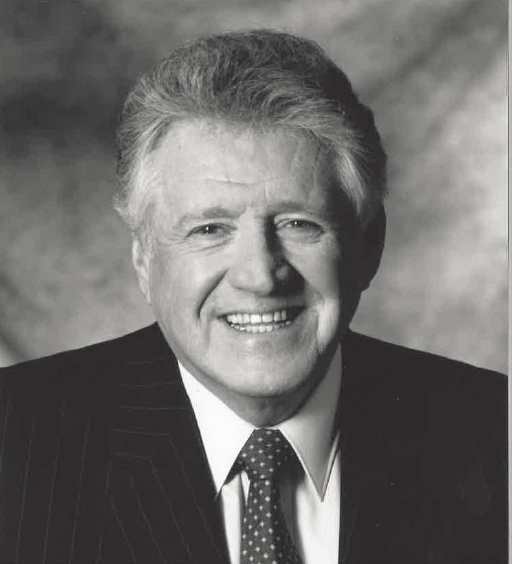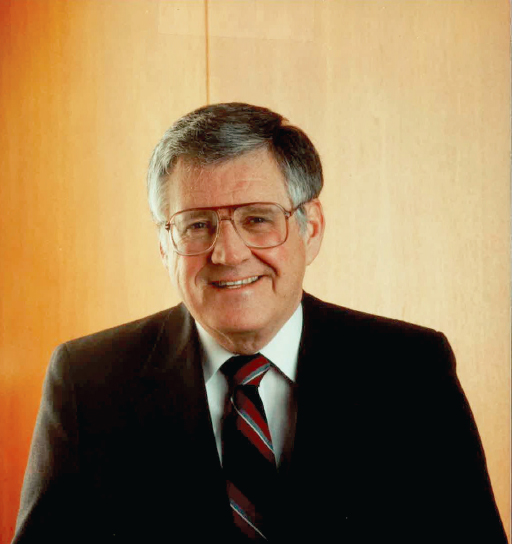DENNIS J. PICARD
1932–2019
Elected in 1990
“For leadership in development of radar computer systems essential for national security.”
BY MARK E. RUSSELL
DENNIS J. PICARD, a defense industry legend and leader, who as Raytheon Company’s chair and CEO led the company through a historic era of industry consolidation and helped it emerge as a global leader in defense technology, passed away October 21, 2019, in Concord, Massachusetts, at the age of 87.
He was a dedicated and widely respected engineer and business leader, and one not shy in dealing with comment and controversy. He was very highly regarded in engineering circles for his knowledge and expertise in the design of large strategic radars, missile guidance systems, and ballistic missile defense. In the defense industry he was well known as a demanding manager, a persistent and implacable competitor, and for his ability to assemble and lead outstanding teams of engineering and technical professionals and business managers.
Dennis Picard was born to Joseph and Louise Picard in North Providence, Rhode Island, on August 25, 1932, and was a graduate of LaSalle Academy. After service with the Air Force in the United States and overseas during the Korean War, he attended RCA Institute in New York and graduated as a licensed broadcast engineer. He opened a TV repair business in the basement of his parents’ RI home.
He began his career as an engineering assistant at Raytheon’s Waltham operation in 1955, after famously getting
lost en route to a scheduled interview at GTE’s Waltham plant; as he slowed traffic while struggling to read a map, a policeman directed him to a Raytheon hiring center instead. During his early days with the company, he concurrently completed bachelor’s degrees in electrical engineering and management at Northeastern University, graduating cum laude in 1962.
He rose rapidly through Raytheon’s engineering ranks and into program and general management, becoming CEO in 1991; he retired as CEO in 1998, as chair in 1999, and remained on the company’s board of directors until 2000. His career with the company spanned 44 years, from the early days of the growth of electronics, radar, and guided missile technologies through the first Gulf War and the subsequent wrenching consolidations of the defense industry.
An engineer by training as well as a registered professional engineer, he was tapped in 1983 to lead Raytheon’s Missile Systems Division, specifically to help complete the Patriot defense system. He helped turn around the program, which was then designed to defend against aircraft, and championed its development as an antimissile system.
He succeeded long-time Raytheon CEO Tom Phillips (NAE 1971) in March 1991, shortly after the Patriot rose to fame during the Gulf War. He engineered the company’s mid-1990s acquisition of E-Systems and the defense units of Chrysler, Texas Instruments, and Hughes Electronics. As he said about the negotiations, “They were our archrivals. It was like the Red Sox and Yankees suddenly having to work together.” The acquisitions, which took place during a period of unprecedented industry consolidation triggered by post–Cold War budget cuts, doubled the size of Raytheon and enabled it to become one of the world’s largest defense contractors.
Picard took a broad view of his responsibilities to the community, beyond those of his corporate position. In the mid-1990s he grew concerned about the departure of manufacturing companies—and jobs—from Massachusetts, largely because of burdensome taxes that directly affected the manufacturing sector. He spearheaded an alliance of corporate, labor, academic, and political leaders that eventually succeeded in
passing legislation establishing a new basis for the state’s taxation of manufacturing industries.
He was a member of the Business Council and the National Business Roundtable, and a former member of the Defense Policy Advisory Committee on Trade, the President’s National Security Telecommunications Advisory Committee, and the President’s Export Council. He had also served as a trustee of Northeastern University and Bentley University, director of State Street Boston Corporation and the Discovery Museum of Acton, MA, and member of the advisory committee of the American Red Cross.
For the National Academy of Engineering, he served on the Council’s Industry Advisory Board (1997–2000) and the Fritz J. and Dolores H. Russ Prize Committee (2006–09).
Picard was broadly recognized and rewarded for his contributions, beginning with his NAE election in 1990. He was an honorary fellow and past president of the American Institute of Aeronautics and Astronautics, and a life fellow of the Institute of Electrical and Electronics Engineers, having been cited by IEEE for his “leadership in the development and implementation of large phased array radars.” In addition, the IEEE Dennis J. Picard Medal for Radar Technologies and Applications was established in 1999, sponsored by Raytheon, to honor outstanding accomplishments in advancing the fields of radar technologies and their applications.
In 1991 he was inducted into the US Army’s Order of Santa Barbara, and in 1996 he received the National Security Industrial Association’s Environmental Achievement Award. In March 1997 he was honored by the Navy League of the United States with the Fleet Admiral Chester W. Nimitz Award “for outstanding contributions to the United States’ Maritime Strength”; in May he was selected for the Intrepid Museum Foundation’s Intrepid Salute Award for his “support of the men and women of America’s armed forces”; in September he received the John R. Alison Award from the US Air Force Association; and in October the Association of the US Army presented him with its John W. Dixon Award. Also that year he was named “New Englander of the Year”
by the New England Council and received the Ralph Lowell Distinguished Citizen Award from the Boston Minuteman Council of the Boy Scouts of America. In 1998 he received the Industrial Leadership Award from the National Defense Industrial Association, the Semper Fidelis Award of the Marine Corps Scholarship Foundation, and, from the Navy League–New York Council, the Rear Admiral John J. Bergen Leadership Medal for Industry. He received honorary doctorates from Northeastern University, Merrimack College, and Bentley University.
He felt strongly about the value of education and, among other substantial gifts to his alma mater, established the Dennis Picard Engineering Legacy Scholarship. In his honor Raytheon endowed the Dennis Picard Trustee Professorship in electrical and computer engineering at Northeastern.
Picard was an avid fisherman and boater, sailing out of Harwich Port on Cape Cod, where he was an active member and past board member of the Allen Harbor Yacht Club. He also loved skiing, hockey, the Boston Bruins, the New England Patriots, and spending time with his children and grandchildren, for whom, and for his many friends, he was always a much-appreciated problem solver.
He was the beloved husband of Dolores M. (née Petit) Picard, whom he married in 1953, and the loving father of their five children: Dennis J. Picard Jr. (wife Joan), Mary Doherty (husband Dennis), Ken Picard (partner Colleen), Sharon Ayoob (husband Mitchell), and Linda Jones (husband Keith). He is also survived by eight grandchildren and four great-grandchildren.








